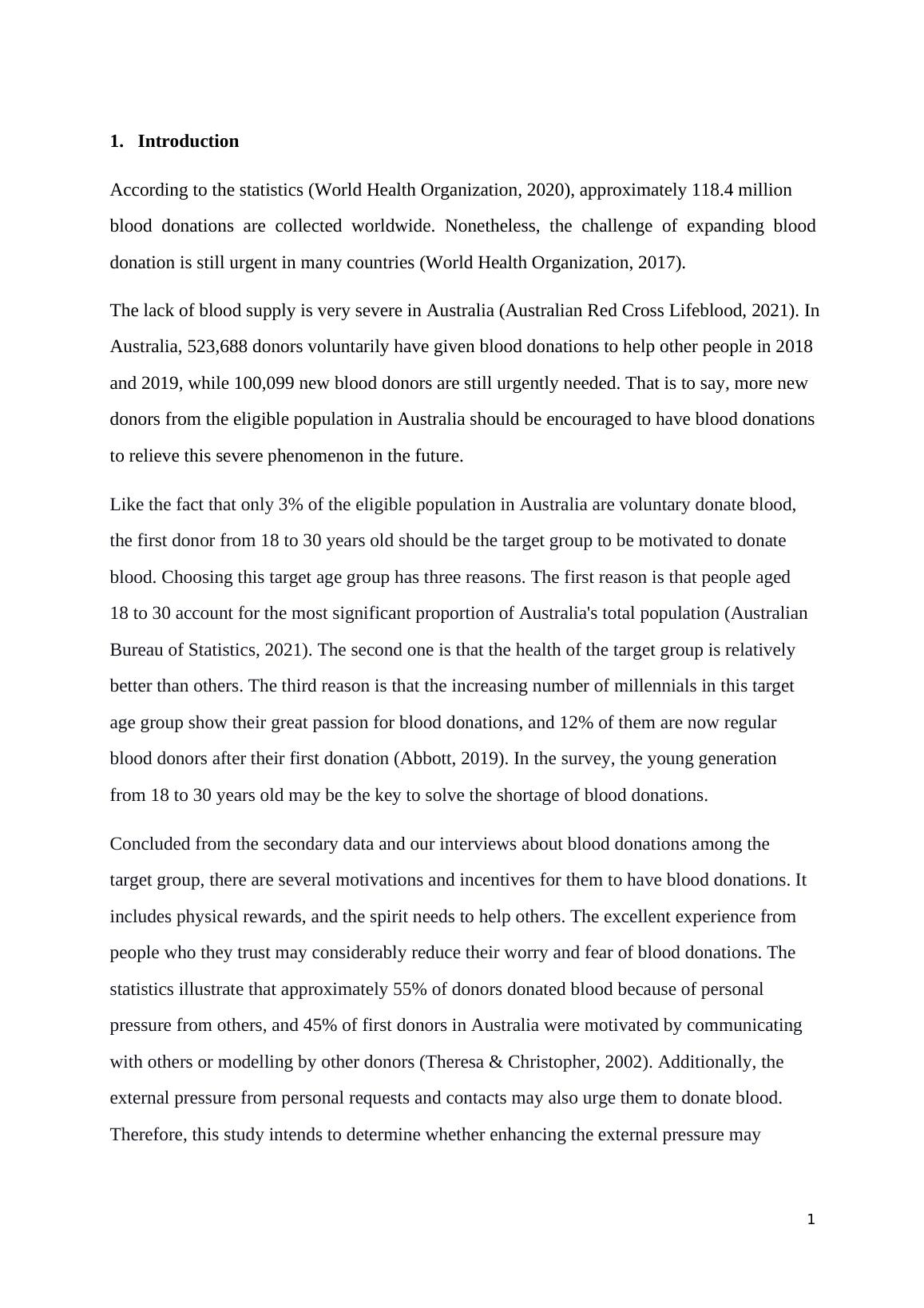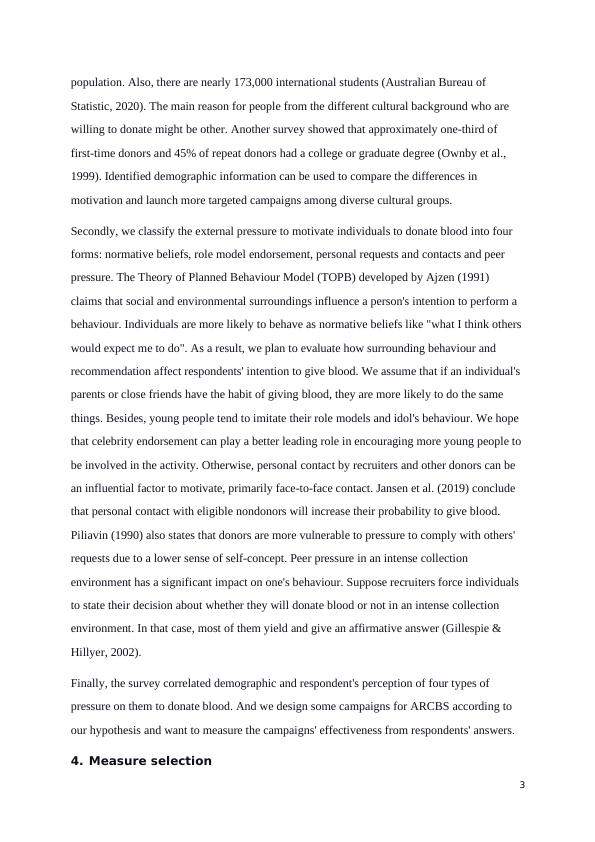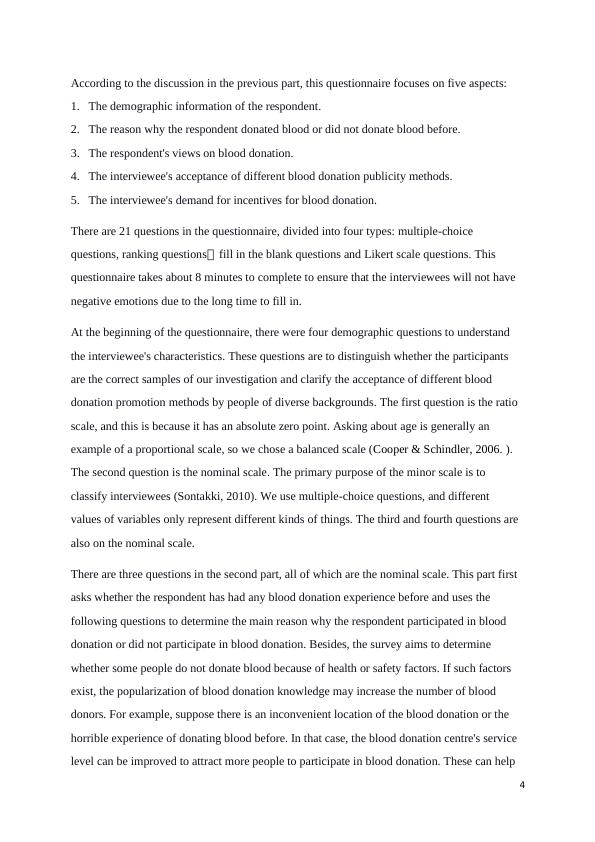Introduction According to the Statistics
Added on 2021-06-22
14 Pages3948 Words107 Views
1 1.Introduction According to the statistics (World Health Organization, 2020), approximately 118.4 million blood donations are collected worldwide. Nonetheless, the challenge of expanding blood donation is still urgent in many countries (World Health Organization, 2017). The lack of blood supply is very severe in Australia (Australian Red Cross Lifeblood, 2021). In Australia, 523,688 donors voluntarily have given blood donations to help other people in 2018 and 2019, while 100,099 new blood donors are still urgently needed. That is to say, more new donors from the eligible population in Australia should be encouraged to have blood donations to relieve this severe phenomenon in the future. Like the fact that only 3% of the eligible population in Australia are voluntary donate blood, the first donor from 18 to 30 years old should be the target group to be motivated to donate blood. Choosing this target age group has three reasons. The first reason is that people aged 18 to 30 account for the most significant proportion of Australia's total population (Australian Bureau of Statistics, 2021). The second one is that the health of the target group is relatively better than others. The third reason is that the increasing number of millennials in this target age group show their great passion for blood donations, and 12% of them are now regular blood donors after their first donation (Abbott, 2019). In the survey, the young generation from 18 to 30 years old may be the key to solve the shortage of blood donations. Concluded from the secondary data and our interviews about blood donations among the target group, there are several motivations and incentives for them to have blood donations. It includes physical rewards, and the spirit needs to help others. The excellent experience from people who they trust may considerably reduce their worry and fear of blood donations. The statistics illustrate that approximately 55% of donors donated blood because of personal pressure from others, and 45% of first donors in Australia were motivated by communicating with others or modelling by other donors (Theresa & Christopher, 2002). Additionally, the external pressure from personal requests and contacts may also urge them to donate blood. Therefore, this study intends to determine whether enhancing the external pressure may

2 positively help the Australian Red Cross Blood Service (ARCBS) attract more first donors and find out what actions ARCBS takes to broaden its blood donor base in the best way. 2.Research objectives and hypothesis The study's hypothesis is to work out whether enhancing external pressure will have positive impacts on attracting more first donors whose age from 18 to 30 years old. This study's external pressure will be defined as the pressure from relatives and friends who donated before, peer pressure, reference groups such as recommendations from other donors or communications with other donors, role models acting by celebrities or other donors and personal requests or contacts through different approaches. The study has three objectives. Firstly, the survey aims to know whether external pressure will impact the first donor aged 18 to 30 years old in Australia to ensure that strengthening the external force will be adequate to expand blood donations. Secondly, basing on the first objective, the survey attempts to reveal the most effective and influential external pressure to the target group as it can help ARCBS have a narrow focus. Thirdly, the survey would like to determine what approaches or actions of enhancing external pressure will affect the target group to the greatest extent. To achieve these three objectives, we hope that the result will help ARCBS acquire a right and efficient way of enhancing external pressure to attract more young eligible donors in the future. 3.Specific aspects measured To explore our hypothesis concerning the external pressure to motivate young Australians to donate blood, we will need to measure the respondents' demographic characteristics, the motivators and barriers for respondents to donate blood or not, how will four types of pressure exert their impact upon respondents' intention to donate blood and respondents' perception of marketing campaigns designed for the ARCBS. Firstly, respondents' demographic characteristics should be identified. Although our target group of subjects is young Australians from 18-30, gender, age, race, ethnicity, and education play important roles in predicting blood donation behaviours. For example, as a multicultural society, ethnic minorities such as Asian and Indian account for over 25% of Australia's whole

3 population. Also, there are nearly 173,000 international students (Australian Bureau of Statistic, 2020). The main reason for people from the different cultural background who are willing to donate might be other. Another survey showed that approximately one-third of first-time donors and 45% of repeat donors had a college or graduate degree (Ownby et al., 1999). Identified demographic information can be used to compare the differences in motivation and launch more targeted campaigns among diverse cultural groups. Secondly, we classify the external pressure to motivate individuals to donate blood into four forms: normative beliefs, role model endorsement, personal requests and contacts and peer pressure. The Theory of Planned Behaviour Model (TOPB) developed by Ajzen (1991) claims that social and environmental surroundings influence a person's intention to perform a behaviour. Individuals are more likely to behave as normative beliefs like "what I think others would expect me to do". As a result, we plan to evaluate how surrounding behaviour and recommendation affect respondents' intention to give blood. We assume that if an individual's parents or close friends have the habit of giving blood, they are more likely to do the same things. Besides, young people tend to imitate their role models and idol's behaviour. We hope that celebrity endorsement can play a better leading role in encouraging more young people to be involved in the activity. Otherwise, personal contact by recruiters and other donors can be an influential factor to motivate, primarily face-to-face contact. Jansen et al. (2019) conclude that personal contact with eligible nondonors will increase their probability to give blood. Piliavin (1990) also states that donors are more vulnerable to pressure to comply with others' requests due to a lower sense of self-concept. Peer pressure in an intense collection environment has a significant impact on one's behaviour. Suppose recruiters force individuals to state their decision about whether they will donate blood or not in an intense collection environment. In that case, most of them yield and give an affirmative answer (Gillespie & Hillyer, 2002). Finally, the survey correlated demographic and respondent's perception of four types of pressure on them to donate blood. And we design some campaigns for ARCBS according to our hypothesis and want to measure the campaigns' effectiveness from respondents' answers. 4.Measure selection

4 According to the discussion in the previous part, this questionnaire focuses on five aspects: 1.The demographic information of the respondent. 2.The reason why the respondent donated blood or did not donate blood before. 3.The respondent's views on blood donation. 4.The interviewee's acceptance of different blood donation publicity methods. 5.The interviewee's demand for incentives for blood donation. There are 21 questions in the questionnaire, divided into four types: multiple-choice questions, ranking questions,fill in the blank questions and Likert scale questions. This questionnaire takes about 8 minutes to complete to ensure that the interviewees will not have negative emotions due to the long time to fill in. At the beginning of the questionnaire, there were four demographic questions to understand the interviewee's characteristics. These questions are to distinguish whether the participants are the correct samples of our investigation and clarify the acceptance of different blood donation promotion methods by people of diverse backgrounds. The first question is the ratio scale, and this is because it has an absolute zero point. Asking about age is generally an example of a proportional scale, so we chose a balanced scale (Cooper & Schindler, 2006. ). The second question is the nominal scale. The primary purpose of the minor scale is to classify interviewees (Sontakki, 2010). We use multiple-choice questions, and different values of variables only represent different kinds of things. The third and fourth questions are also on the nominal scale. There are three questions in the second part, all of which are the nominal scale. This part first asks whether the respondent has had any blood donation experience before and uses the following questions to determine the main reason why the respondent participated in blood donation or did not participate in blood donation. Besides, the survey aims to determine whether some people do not donate blood because of health or safety factors. If such factors exist, the popularization of blood donation knowledge may increase the number of blood donors. For example, suppose there is an inconvenient location of the blood donation or the horrible experience of donating blood before. In that case, the blood donation centre's service level can be improved to attract more people to participate in blood donation. These can help

End of preview
Want to access all the pages? Upload your documents or become a member.
Related Documents
Case Study on Encouragement of People for Blood Donationlg...
|8
|1296
|122
Motivation and barriers influence blood donation in different age in Australialg...
|11
|2362
|482
Critical Evaluation of Governmental Policies for Housing Affordability in Australialg...
|1
|924
|81
Health Promotion Program for Hypertension: Strategies, Goals, and Evaluationlg...
|18
|1285
|80
Report ‐ Social Determinants of Healthlg...
|4
|2091
|69
Case Analysislg...
|11
|2113
|188
